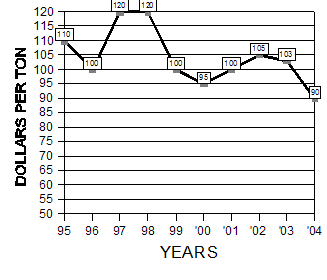Alfalfa Report
Yuma County, Arizona
February 23, 2004
Yuma County Office
2200 W. 28th Street, Ste. 102
Yuma, AZ 85364
(928) 726-3904
(928) 726-8472 FAX
IMPORTANT NOTICE: The alfalfa report will be available exclusively on the internet at http//ag.arizona.edu/crops/counties/yuma/alfalfareports/alfalfareports.html It will no longer be mailed directly to you although a hard copy can be printed from this site. The site contains all previous reports back to August 2000 when it was first posted electronically. A new report will appear every other Monday.
Production Update:
Production Update: Measured vs. Calculated Forage Quality
Values: There is no single forage quality parameter that accurately predicts
animal performance. This leads to confusion about forage quality parameters
in general. To avoid confusion, keep in mind that some forage quality
parameters such as ADF, NDF, and protein, are measured. Other forage quality
parameters, such as TDN and RFV, are calculated from measured values.
The formulas used to generate calculated values can differ, and the formulas
used for TDN in particular vary by region and nutritionist.
Insect Management: Insect management in alfalfa depends on a good monitoring program. Management decisions should be based on suitable sampling methods to estimate insect pests populations. Check fields at least once a week and more often when counts show that a pest population is approaching damaging levels. Correct identification of insect pests and their damage is essential. Several factors need to be considered when sampling insect populations. Time of day can greatly influence the reliability sampling methods. Nocturnal pests hide during the day. Morning dew or strong winds can alter counts of some insects. Sample at several sites in each field quadrant. Choose sampling methods that are reliable for the insect pests being monitored. Avoid field edges for general sampling, but observe field edges for invading insects.
Weed Control: The effectiveness of Eptam is reduced by its high volatility under frequent irrigations. It is still effective, however, in suppressing perennial weeds like Nutsedge and Bermudagrass when multiple applications are made throughout the summer. Applications following the 1st, 3rd, and 5th cuttings are most important.
| Market Summary |
High
|
Low
|
Average
|
Off grade
|
| Past 2 Weeks (Feb 10 - Feb 23, 2004) |
115
|
80
|
90
|
65-75
|
| Last Year (Feb 10 - Feb 23, 2003) |
108
|
95
|
103
|
80-95
|
10 Year Summary (Feb 10 - Feb 23, 1995-2004):

Issued in furtherance of Cooperative Extension work, acts of May 8 and June 30, 1914, in cooperation with the U.S. Department of Agriculture, James A. Christenson, Director Cooperative Extension, College of Agriculture and Life Sciences, The University of Arizona.
The University of Arizona is an equal opportunity, affirmative action institution. The University does not discriminate on the basis of race, color, religion, sex, national origin, age, disability, veteran status, or sexual orientation in its programs and activities.
Any products, services, or organizations that are
mentioned, shown, or indirectly implied in this web document do not imply
endorsement by The University of Arizona.
Information provided by:
Barry Tickes, btickes@ag.arizona.edu Extension Agent, Yuma County
Michael Ottman, mottman@ag.arizona.edu Agronomy Specialist
College of Agriculture, The University of Arizona.
Eric Natwick, etnatwick@ucdavis.edu UCCE Imperial County - Farm Advisor
University of California, Davis, CA.
Forages: Crop Mgmt | Soil Mgmt | Irrigation | Alfalfa Reports | Insects | Diseases | Weeds | Pesticides
Home | Other Crops | Forages
For more Arizona Production Ag Information:
Home | Cotton | Veggies| Forages | Grains | Citrus | Crop x Crop | Insects | Diseases| Weeds | Pesticides | News | Weather | Research | Photos | Contacts | General Info. | Site Map
Copyright © 2001 University of Arizona,
College of Agriculture and Life Sciences
Webmaster: Al Fournier (fournier@ag.arizona.edu)